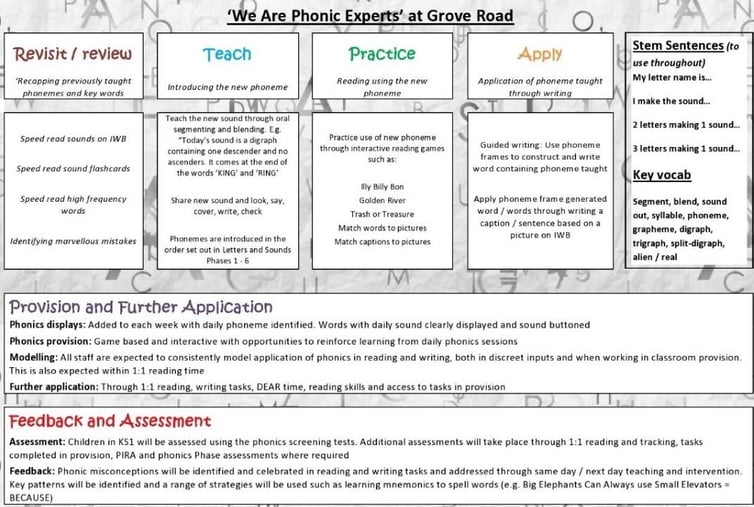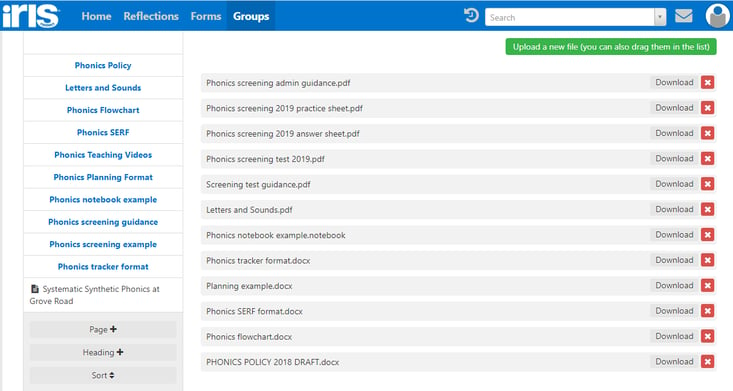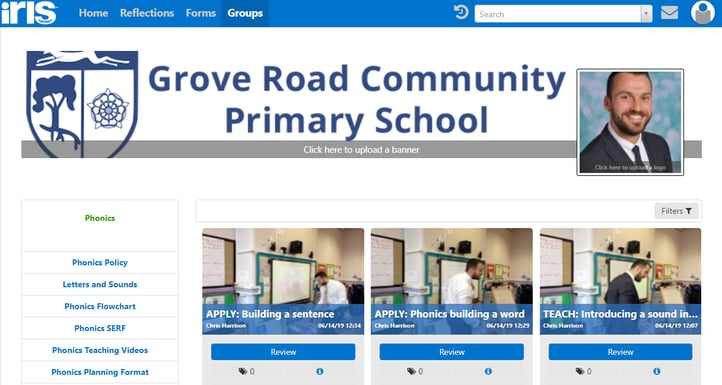Moving to a new school or year group can be a huge challenge; you have to learn new systems, structures and pedagogical styles whilst getting to know your class and the rest of the staff. So, having a central system with banks of resources, lesson clips and templates can be incredibly useful as you settle in school-life and get to know how things work.
With this in mind, we decided to create a number of curriculum groups in IRIS Connect with a view to creating a school pedagogy and curriculum model for our teachers. We’ve gone from recording lessons and running internal film clubs (these were incredibly useful starting points) to now building banks of lessons that help to quality assure the teaching that’s happening in our classrooms. Our teachers can now refer to the platform with approved resources and teaching clips whenever they need it.
In this blog, I share more information about the Phonics Group I have created, which is now being used as a template group for other curriculum areas, and also more information on how we are hoping to develop our use of IRIS Connect Groups to enable sharing and collaboration among staff.
Why create a streamlined system?
We wanted to have a central system with banks of resources, lesson clips and templates all in one place for our teachers to refer to. This starting point could then lead teachers to exploring teaching more confidently, knowing they have the stepping stones available, if needed. It also creates consistency across the school which can, in turn, support transition between year groups moving forward. Streamlining is critical in schools: systems that work well together are far easier to implement effectively and consistently. We have been careful to provide suitable structures and systems without prescribing delivery strategies - as we strongly believe that creativity should be celebrated, not criticised.
Alongside this, it is critical that our subject leaders have a strong grasp on what their subject looks like across school, where the strengths and gaps are, and how these are being addressed. As a school we have removed formal observations completely in favour of learning walks, 20:20 teaching (two members of staff visit each other’s room for 20 minutes covered by SLT, then meet to discuss this after school for 20 minutes) - that being said, staff can request an observation if they would like additional support.
The removal of formal observations has been central in our support of staff wellbeing and self-efficacy. Having a centralised bank of information and videos can be really supportive when tackling those ‘deep dive’ conversations as everything you need is in one place. Also, it can be really hard to get into other classes when you are class-based all the time, therefore we have utilised IRIS Connects’ video tool to support the capturing of practice in a non-invasive, time-saving way.
Creating the system
So where did we start? As we introduced IRIS Connect, we launched regular film clubs. These were times to get together as a phase and share our thoughts and opinions (and popcorn!) whilst watching clips of each other teaching. Films clubs were linked to specific subject areas and strategies, such as the use of Kagan structures in maths, so clips were specific and targeted. These sessions proved to be very useful, with lots of good practice and progress being highlighted within phases and subject areas. From here we started to delve deeper into the use of IRIS Connect ‘Groups’ as a way of collating high quality exemplification and support materials.
Firstly, subject leaders have created pedagogical ‘flowcharts’ for their respective areas. Each curriculum area even includes a photo of the subject leader for that area as that was reported to really help new staff. These charts have gone through a heavy drafting process where all staff have been welcome to input, and as a result the end products continue to be very useful. These have also been informed by recent CPD (both internally and externally with the Local Authority) and many have been audited by Local Authority Consultants and Governors, too.

Following on from this, we have started to build banks of video clips and resources from across school that fit into the flowchart sections, for example: phonics clips for the ‘Practice’ section (phonics flowchart above). These clips are collated and quality assured through learning walks, SERFs (self-evaluation reporting forms) and subject-area film clubs.
We have created banks of resources including planning, notebooks, CPD recordings, full lesson examples (following the flowcharts), data templates and policies all shared in one central location. Here is the list of resources and attached documents on the Phonics Group for example (below).

As each member of staff logs into the group, the first thing they see is the flowchart and subject leader. The reason for this is simple: this provides a concise overview of that subject area and it signposts who to speak to if you need a helping hand. Following this, staff can look through the attached documents (above) and watch the videos linked to the flowcharts (right).

What have we noticed?
Our curriculum resources are growing, one film club at a time, and engagement has been good. Staff have become increasingly more confident when sharing videos and as a result subject leaders are more comfortable when discussing their areas of leadership. Consistency in teaching and learning across our school is strong; highlighted through learning walks and SERF feedback from staff. Also, new staff (including NQTs) feel really well looked after. The NQT I mentor, for example, regularly refers to our IRIS Connect bank of resources and we use teaching clips to discuss his progress on a weekly basis using the time-stamped comments to build up a dialogue. This can easily track back to the subject groups and has made the feedback process far more straightforward and effective. It is also wonderful to see the confidence grow in our staff when their clips are highlighted as being of a high quality; importantly though, we always seek their permission before sharing them into the subject groups, as ultimately the clips of their teaching belong to them.
Next steps:
As mentioned previously, our next steps are to continue to grow each subject area through our film clubs and the sharing of good practice. We aim to spend at least 1-2 years growing the system methodically so that it is both consistent and of the highest quality.
Each film club will focus on a specific subject, and each year group will be asked to focus on different stages from the subject flowchart which will cycle throughout the academic year.
Subject leaders are continuing to be given release time to curate their systems and carry out learning walks and SERFs (with Governor and SLT support) to maintain quality and consistency whilst allowing them time to truly know and develop their subject area.
We feel that this streamlined system will be invaluable going forward, not just for those dreaded deep-dives, but also for healthy subject leadership and teacher development.
Guest post written by Chris Harrison, Assistant Headteacher, Grove Road Community Primary School. Twitter account: @MrHtheteacher
Find out more about how IRIS Connect can support your school >



Leave a comment:
Get blog notifications
Keep up to date with our latest professional learning blogs.